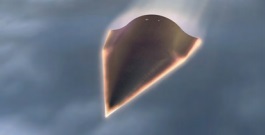Chapter: Hypersonics and Space Technologies, new invention technology, Research project papers,
Advanced Control Method for Hypersonic Vehicles

Advanced Control Method for
Hypersonic Vehicles
This research effort
aims to develop software control algorithms that will correct for roll reversal
before it happens. Roll reversal occurs when an aircraft is steered in one
direction but rolls the opposite way due to aerodynamic conditions. The problem
often compounds as a pilot attempts to correct for the motion by over-steering
in the original direction, leading to uncontrollable roll. Unexpected yaw and
subsequent roll reversal has caused the loss of high-speed, lifting body-like
vehicles. The team has employed novel predictive software
within adaptive
controller technology to detect conditions likely to result in aircraft roll
reversal and then automate compensating maneuvers to avoid catastrophic loss.
Work to date: University of
Michigan's retrospective cost model refinement (RCMR) control
algorithm has been integrated into a flight simulator and tested with
prerecorded, open-source parameter data, which replicates the roll reversal
anomaly.
Looking ahead: Next steps involve
upgrading the RCMR code to account for a six-degree-of-simulation
environment (forward/back, up/ down, left/right, pitch, yaw, and roll) with
eventual application in a flight test environment.
Partners: University of Michigan, other government
research agencies, and aerospace firms.
Benefits
Operates
independently: Unlike other standard control systems, this method
allows for compensation and control of aircraft roll reversal without a
priori knowledge of the dynamics.
Improves safety: This technology is expected
to prevent crashes that occur due to uncontrolled roll.
Increases envelope: RCMR would enable planes
to travel safely over a larger envelope.
Applications
Hypersonic jets
Lifting body-type space vehicles and reentry vehicles
Hypersonics and Space Technologies
Akey objective of hypersonic research at NASA is to develop
methods and tools that adequately model fundamental physics and allow credible
physics-based optimization for future operational hypersonic vehicle systems.
Research focuses on solving some of the most difficult challenges in hypersonic
flight, and Armstrong innovators are contributing to this research in several
ways:
- Exploring adaptive guidance systems
that could detect conditions likely to result in dangerous situations and
automate compensating maneuvers
- Modeling high-altitude
environments to improve flight planning designs for high-speed vehicles
- Designing high-temperature
insulative and advanced composite materials
This research will enable the development of highly reliable and
efficient hypersonic systems.
Related Topics